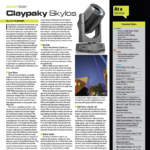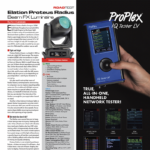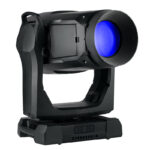It reflects a natural progression of a company already deeply involved in gear that distributes various lighting protocols across the network. And the new look reflects the fact that, instead of mimicking existing consoles, Pathway Connectivity (pathwayconnect.com) assembled a team including Robert Bell, Eric Cornwell, Gary Douglas, Alan Martello and Philip Nye to build a new console from the ground up.
What It Is
The Cognito is a small, portable lighting controller with a user-friendly interface combined with a powerful backend. Geared mainly for smaller-to-medium sized venues, the Cognito console’s control range can vary from a single universe or dual universe of output, depending on which model you go with.
Small enough to easily fit in a backpack, the Cognito is perfect for those quick gigs or smaller touring shows. The console has 20 sliders, four rotary encoders, two playback sections and the best part, a 7-inch capacitive touch screen. The entire console is about the same size as a 17-inch laptop, minus the screen.
Connectivity
Despite its compact size, the Cognito console’s back panel has connectivity galore. There is an PoE Ethernet port, two 5-pin DMX ports, (one in and one out), MIDI in/thru/out, RS232, two USB ports, one USB B port and an audio jack— nearly matching the back panel of much larger lighting consoles. As for control protocols you can take your pick: DMX512, Pathport, Art-Net or sACN.
Touching Your Lights
I found the 7-inch touch screen at the center of the console to serve as my “home base” for lighting control. Everything happens here — from selection, adjusting and manipulating my rig to various controls and playbacks.
It took me a while to get used to the layout and graphics, which present a different experience than using other consoles. But after a short and quick learning curve, I felt that I was able to master the console.
Simple Operation
I’m familiar with the syntax and programming functions of a number of consoles, and I like to jump right into a new desk and play around with it, figuring things out on my own. So starting cold on the Cognito was a slight challenge, particularly in terms of getting acquainted with patching.
Luckily, Pathway developed a quick start guide and offers YouTube videos (www.plsn.me/CognitoVideos) to get new users up and running. Turns out my slight problem with patching was just locating it on the desk. Once I found it, I was up and flying in no time, using the console to control different LED fixtures, moving lights and a couple of PAR cans on dimmers.
Patching and Control
Patching on the Cognito turns out to be very easy. The console makes use of fixture templates or personalities. Arm the Cognito with basic data including fixture make,
model, address and preferred control channel, and you’re pretty much done.
Controlling an individual fixture is a bit different, but similar to other consoles on the market. Yes, one channel operates the entire fixture and then the parameters on encoders, but it is how you select the fixture that differs from others. I am a number pad kind of guy. I work best with typing a fixture number in, taking it to a level and then adjusting the parameters. The Cognito follows that thought process, but not when selecting. Since there is no number pad, only a touchscreen, you touch the fixtures and then go to the encoders.
There is no command line to learn; you manage images, not numbers. The “fixture sheet” is all images, colors and representations of what your fixtures parameters are doing. If you have an LED fixture in orange, the circle for that fixture channel shows in orange. How about the intensity of that light? The outer ring shows how bright it is, going clockwise around the outside. The Cognito lets you forget the numbers. Just look to the fixture sheet to graphically show what you lights are doing.
Effects Made Easy
If you have ever built an effect, you know how tedious it can be. On the Cognito, most of what you use on daily basis is already there. Say you want a range of fixtures to do a rainbow spread. You select them, switch to effects, press the rainbow effect, and you’re done. Of course, there are times when you need a special effect. Building them with the Cognito is just as easy. You can then save it for later in the effects library, and up pops a simple image of what you made, along with the custom name you gave it.
Recording and Playback.
Throw out the thought of being constrained by limitations on cue numbers or memories. Pathway offers unlimited control in storing and playing back your cues and lists. After learning the Cognito’s style of recording, you can quickly build a cue list on either one of the two playback sections or the memory sliders at the top. This process won’t feel entirely alien for those with experience using other control surfaces.
External Controls
Pathway has thought about what users want and how they control their rigs. If a physical console is not your thing, they offer a software version of the Cognito for both PC and Mac. Taking it a step further, for remote controls and external display and additional faders, Pathway offers a free iOS app, Neato (www.plsn.me/NeatoiOS).
Summing Up
The Cognito might look different than other consoles, but I fell in love with using it. After about five minutes getting used to the novel interface and use of colors and graphics for encoders and buttons, I found the programming process to be basically very similar to other consoles I have used. I know what RFTM stands for, but in this case, when I did get stuck, I was able to bypass the manual and use the Cognito’s built-in help feature, which clearly steers you toward what you need to do to accomplish what you are trying to do.
Cognito Features:
With all of its power and functions, the Cognito can fit nicely into any small to medium-size rig. Depending on which version of the console you go with, you can operate a single universe of 512 DMX or up to two universes. Be sure to check out the features of the Starter, Pro512 or the Pro1024 models in the chart below to ensure that you will have access to the features and functions you are looking for.
• Size: 18.3” x 11.2” x 3.1”
•Weight: 8 lbs.
|
Features |
Starter |
Pro512 |
Pro1024 |
|
Output Addresses |
512 |
512 |
1024 |
|
Pathport Protocol |
Yes |
Yes |
Yes |
|
ANSI E1.31 sACN |
No |
Yes |
Yes |
|
Art-Net |
No |
Yes |
Yes |
|
DMX512 OUT Ports |
1 |
2* |
2 |
|
DMX512 IN Ports |
Not enabled |
Yes |
Yes |
|
MIDI Show Control |
Not enabled |
Yes |
Yes |
|
RS232 Port |
Not enabled |
Yes |
Yes |
|
Contact Closure |
Not enabled |
3 |
3 |
|
Retail Price |
$3,700 |
$4,200 |
$5,200 |
*Universe 1 repeated on both OUT ports



